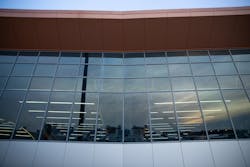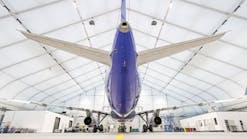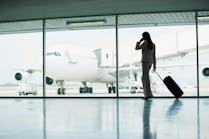As airports and airlines gradually ease lock-down restrictions, two things are clear: Americans want to fly again, but also that there’s concern about how they can navigate travel safely.
Airports have adopted many travel policies and practices simply because people expect them—temperature checks and hand washing signs are good examples. But according to a recent national survey of travelers, if the industry wants to get people flying again, it needs to take the right steps to restore passenger confidence in the airport as an environment that protects passenger health and safety. The question is: How?
In May 2020, global architecture firm Gensler and View—a technology company whose smart windows improve people’s health—surveyed 970 people across the U.S. to better understand their attitudes toward travel in a COVID-19 reality. The results identify several solutions for the aviation industry on how to rebuild passenger trust in airports through technology-enabled design.
According to the survey, personal health and the health of others are the top priorities for passengers. More than 70 percent said that concern about the airport as a healthy environment is a greater priority now than in January.
Interestingly, we found that people’s concerns vary on how frequently they travel. Infrequent travelers—those who take zero to one flight per month—were overwhelmingly concerned with the flight itself (75 percent). But for the most frequent travelers—those who take more than five flights per month for business or personal reasons—it’s the airport, not the flight, that’s the highest area of concern (49 percent).
Restoring passenger confidence is not an academic exercise. During our research, passengers reported that they would return to travel several months sooner if they were confident in airport health policies. Frequent travelers identified three key areas of concern inside the airport: baggage check, security, and the gate area. It’s clear that the passenger experience must be modified and improved in each of those areas through improved airport design and operations.
In May, just 20 percent of travelers said they were comfortable traveling. As time goes by, they report a moderate increase in travel comfort—reaching 50 percent by December 2020. But our survey also shows that without confidence in the airport environment, passengers won’t reach that 90 percent milestone until December of 2021. By investing in design that can make passengers feel more confident, airports can accelerate the return travel by up to eight months. For this reason, it’s important that airports take steps toward building a healthy airport environment now.
In order to eliminate the stress points in the airport experience and restore confidence, the first step is to address the main passenger requirements in a COVID-19 world. Physical distancing, touchless technology, and environmental monitoring top the list as must haves for today’s travelers. These measures must be implemented from the curbside to the boarding gate, and everywhere in between.
A critical moment in a passenger’s confidence occurs before they even walk through the revolving door. At airport entry points, travelers want to see smart procedures to limit the spread of COVID-19. In a reimagined airport experience, passengers will be greeted at the curbside and other airport entry points with a touchless kiosk to monitor health and secure entry. A temperature check and questionnaire will be performed in a seamless manner to minimize lines and prevent potential disease spread. Ideally, this is all integrated with the traveler’s airline app, providing a frictionless passenger experience.
With or without entry point screening, packed queues for bag check and dense, high-touch TSA security checkpoints are notable stressors for frequent travelers during the pandemic. These need to be faster, touchless, and designed to maintain physical distancing. Redesigning layouts and queuing strategies, combined with leveraging new touchless technologies, can speed up processing, minimize the wait, and keep everyone at safe distances.
Finally, once passengers get through security, they need to be able to move freely and with confidence. Passengers want to return to their comfortable shopping, dining, and waiting habits in an environment that prioritizes their safety. Our research shows that 86 percent of frequent travelers feel that real-time display of environmental conditions at the gate would restore their confidence in the airport’s safety the most. Best-in-class airports already deliver clean air via a multi-stage filtration process, but new technology needs to be put in place to measure conditions at the passenger location and then present the information in a clear and unobtrusive way. Surfaces need to be cleaned regularly and when possible, continuously monitored with similar technology.
There’s a common belief in the aviation industry that the COVID-19 epidemic will require a three-year recovery. Solving such a big problem may sound daunting, but airports have a history of making big investments toward rapid change. In the wake of 9/11, DFW alone spent more than $160 million to re-tool their airport for advanced threat screening. The measures our research proposes are a small fraction of that cost and could become the new normal.
Also, it’s important to note that the benefits of healthy building design will extend beyond our current crisis. We will have a vaccine in the future, but there’s no predicting what the next crisis will look like. A smart airport environment that supports passenger health is an important safeguard against an uncertain future. Technologies can be quickly upgraded and adapted to the next threat. Airports that people have an established trust in will also be less prone to the loss of passenger volume they experienced this year.
In summary, these results tell us that changes to the design and operation of airports that help passengers feel more confident are critical to the recovery and future profitability of the aviation sector. If we can take these steps now to help restore people’s trust in the airport environment, they will ultimately make the traveler experience better for everyone in the long-term, and encourage even more people to fly again.
Brandon Tinianov is View’s VP of Industry Strategy where he leads their research and industry engagement initiatives. His work spans current trends in commercial real estate, workplace strategy, and the impact of the built environment on health and wellness. He is a member of the Board of Directors of the US Green Building Council. Brandon has a PhD in Engineering Systems, is a registered Professional Engineer and a LEED AP.







